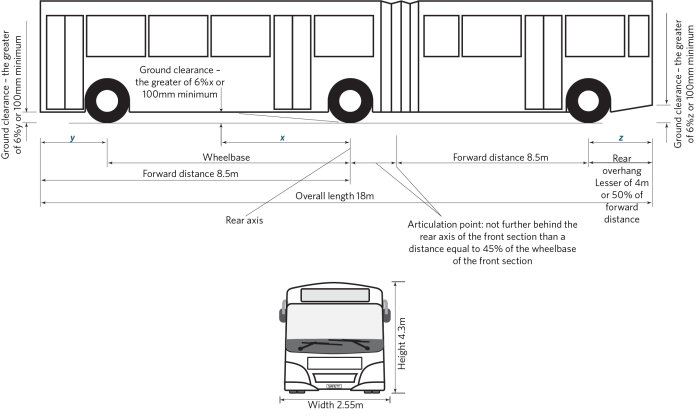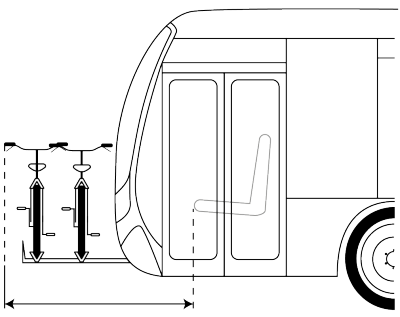This page describes additional dimension requirements in the Land Transport Rule: Vehicle Dimensions and Mass 2016 for heavy buses (classes MD3, MD4 and ME).
Also read Vehicle dimensions and mass – general information
Heavy buses – sometimes called omnibuses – have a gross vehicle mass (GVM) of more than 3500 kilograms. They are classes MD3, MD4 and ME vehicles.
Heavy buses must meet the requirements for heavy rigid vehicles in addition to the requirements in this factsheet.
More information about general vehicle dimension and mass limits
More information about heavy rigid vehicles
Heavy buses have a maximum legal speed limit of 90km/h.
Vehicles used as school buses are limited to a maximum open road speed limit of 80km/h (see sub clause 5.6(2) of Land Transport (Road User) Rule 2004).
The width and height measurements for a trolley bus do not include trolley bus poles and their safety cables, when extended to collect electric power from overhead conducting wires, provided there is a 2.5 metres ground clearance outside the body of the bus.
Heavy buses must comply with the stability and structural strength requirements in section 7 of Land Transport Rule: Passenger Service Vehicles 1999.
A rigid bus must meet the requirements of all rigid vehicles, refer to Heavy rigid vehicles. However, there is a special dispensation in the Vehicle Dimensions and Mass Rule to allow 13.5 metres maximum length for a heavy bus, provided it has three axles where the rearmost axle is a single-tyred steering axle that is:
either positively and continuously linked to the front steer axle (except may be locked for reverse and highspeed operations), or
automatically locked at a speed of 30km/h in the straight-ahead position and for reverse operations. This dispensation was made to assist with public transport and tourism.
Articulated buses have a driver’s seat, a steering system, motive power and two rigid sections that articulate relative to each other. They have interconnecting compartments that allow passengers to move between them and are permanently coupled together.

Articulated buses have three axle sets and have special requirements, as follows:
Maximum length: 18 metres.
Rear axis position: Both front and rear sections of the bus have a rear axis. If the axle supporting the rear section is a steering axle, the NZ Transport Agency will determine the position of the rear axis of the rear section.
Forward distance: 8.5 metres (both front and rear sections). The forward distance of the rear section is the distance from the rear axis of the rear section to the articulation point.
Rear overhang: The lesser of 4 metres or 50 percent of the forward distance of the rear section.
Articulation point: Not further behind the rear axis of the front section than a distance equal to 45 percent of the wheelbase of the front section.
Turning circle: For a 360 degree turn, the maximum outside diameter is 25 metres. The minimum inside radius is 5.3 metres.
An articulated bus is not allowed to tow a trailer.
This dispensation was made to assist with intermodal transport and public health.
The Rule allows a bike rack to be fitted to the front of a heavy bus, provided the vehicle can still manoeuvre adequately (swept-path requirement – see Vehicle dimensions and mass). However, the vehicle must still be checked at the certification of fitness (CoF) inspection to make sure the other safety requirements are met.
If the swept-path requirements are met then the extra length of the load (usually about 1 metre) does not need to be included in the measurement of the length and forward distance of the bus.
However, the loaded bike rack (with bikes mounted) must still meet the front overhang requirement of not more than 3 metres from the front of the driver’s seat in its rearmost position.
The bike rack when loaded or folded away must still meet the requirements of the Land Transport Rule: External Projections 2001 and driver's visibility must not be affected.
